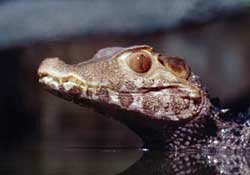 Dwarf Caiman Dwarf Caiman
Do you want to see a caiman eat?
Download the free software Quick Time Video
Caiman Feeding (3.1Mb)
Caiman Feeding (8.9Mb)
scientific name
Paleosuchus palpebrosus
size
Length: males 4.9-5.2 ft, females 3.9 f
characteristics
Color: Skin heavily armored with bone on back and stomach, protection from predators and reduces injury in fast-flowing rivers and while walking on land " short smooth head with high skull and upturned snout, upper jaw overlaps lower jaw " juveniles brown with blank banding ,adults darker head chocolate brown " eye iris chocolate brown " lower jaw has white bands
Face: teeth 78-82 short backward curved
Behavior: burrows for long periods in day " travels over land at night " lives singly or in pairs
reproduction/life span
Nesting. females nest in mounds of vegetation and mud built concealed and under cover " clutch 10-25 eggs
Breeding season: not noted
Incubation: about 90 days
Hatchlings: hatchlings covered with slow-drying mucus " may not enter water until end of first day " mother may open nest and move young to water but no other care following hatching has been noted
diet
Wild: juvenile - small invertebrates " adults fish, crabs, mollusks, shrimp, terrestrial invertebrates
Zoo:
habitat/range
Habitat: freshwater forest areas " flooded forests " prefers clean, faster flowing river areas
Range: Bolivia, Brazil, Colombia, Ecuador, French Guiana, Guyana, Paraguay, Peru, Surinam, Venezuela
status
Cites II IUCN Low Risk
other
also called Cuviers dwarf caiman, Cuviers smooth fronted caiman, Cachirré, Jacaré pagua, Coea, Musky caiman
note
smallest living crocodilian species" threatened by habitat destruction and water pollution (from gold mining)
oregon zoo exhibit
Amazon
back to top
|


